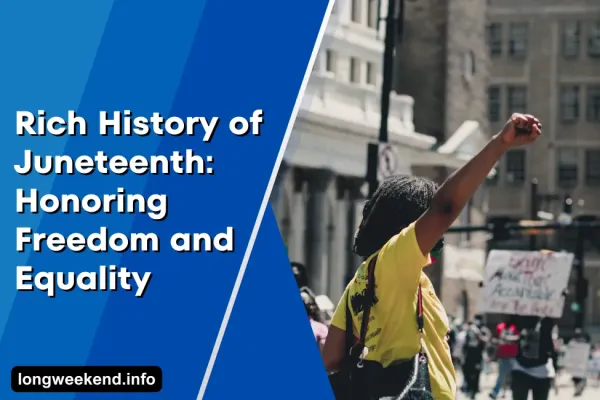The American people hold a special place in their hearts for Labor Day, which is a cherished and widely awaited vacation. On this day, the people of the United States celebrate and contemplate. This annual milestone, nestled within the calendar, pays tribute to the sweat, determination, and dedication of the American workforce. It's not just a day off, but a moment to honor the toil that shapes the nation's prosperity.
Introduction to Labor Day
-
Brief Explanation of Labor Day's Significance
As September arrives, so does the significance of Labor Day, a dedicated nod to the backbone of the nation—the labor force. This pivotal holiday acknowledges the relentless efforts of workers across industries, from towering skyscrapers to humming factories. It's a reminder that every brick laid, every keystroke made, contributes to the vibrant tapestry of the United States.
-
Mention Its Historical and Cultural Importance
Labor Day's roots dig deep into the soil of American history. It emerged during a time when sweat-soaked laborers sought solace from grueling work conditions. The labor movement, born out of these aspirations, fought tenaciously for rights that often went overlooked. The echoes of their struggles are heard in the parade chants and sizzling barbecues of today's celebrations.
Beyond history, Labor Day paints a portrait of a culture. It's a bridge between the final rays of summer and the imminent fall, where families and friends gather for one last hurrah. Parades wind through streets, and flags flap in unison, reminding us of the unity that defines the spirit of the nation.
Origins of Labor Day
The Genesis of Labor Day is a tale woven with the threads of courage and resilience, unfolding against the backdrop of the late 19th century—a time of transformative upheaval and a fervent rise of the labor movement. This epoch was a crucible of change, igniting a beacon of recognition for the valorous workforce that toiled tirelessly.
-
Rise of the Labor Movement in the Late 19th Century
Amidst the clattering machinery and bustling cities, the labor movement emerged as a vanguard for change, uniting the voices of the laborers and echoing the desire for better days. Their rallying cry for equitable treatment reverberated across industries, knitting together a mosaic of dreams for a fairer tomorrow. This movement, a force of nature, shaped the very bedrock of Labor Day's inception.
-
Early Labor Protests and Demands for Better Working Conditions
In the shadow of towering factories, a symphony of protest unfolded—an anthem of grit and determination. Workers, driven by a fervor for justice, took to the streets to demand humane conditions, to cast aside the shackles of grueling hours and unsafe environments. Their fervent protests laid the groundwork for an observance that stands as a testament to the indomitable spirit of collective action.
-
Highlighting Key Figures like Peter J. McGuire and Matthew Maguire
In this intricate tapestry of labor history, certain names gleam like constellations. Peter J. McGuire, a visionary co-founder of the American Federation of Labor, etched his legacy by advocating for a day dedicated to honoring the workforce's unwavering dedication. Alongside him, Matthew Maguire, a resolute machinist, lent his voice to the call for a national holiday, a beacon of recognition for the laborer's enduring struggle.
Haymarket Affair
The Haymarket Affair of 1886 is seen as a crucial turning point in the history of labor, leaving its mark via a series of incidents that struck at the very heart of workers' ambitions. The labor movement was forever changed by this episode, which was the result of tensions and ambitions coming together. It also sheds light on the never-ending pursuit of justice.
-
Explanation of the Haymarket Affair of 1886
Amidst the bustling streets of Chicago, a gathering of labor advocates sought to amplify their voices for workers' rights. The event began as a peaceful rally to champion the cause of an eight-hour workday—an emblem of dignity and humane treatment for the labor force. However, the tranquility was soon shattered by a violent clash, culminating in a bomb explosion that left scars on the city's landscape and the pages of history.
-
How the Incident Influenced the Labor Movement?
The echoes of the bomb's detonation reverberated far beyond that fateful day. In the wake of the Haymarket Affair, numerous labor leaders were detained and put on trial, casting suspicion and unease over the labor movement. Even while the incident itself was unfortunate, it inspired the labor movement, fostering a fresh feeling of togetherness and will to fight for workers' rights in the face of opposition. The Haymarket Affair's history serves as a constant reminder that the pursuit of justice frequently necessitates making significant sacrifices.
-
Connection to the Fight for an Eight-Hour Workday
At the heart of the Haymarket Affair lay the fervent desire for an eight-hour workday—a dream that was ignited by the belief that laborers deserved not just the right to livelihood, but also the privilege of a life outside work's relentless grasp. The incident amplified the urgency of this cause, propelling the movement forward and eventually leading to the establishment of an eight-hour workday as a standard across industries.
Pullman Strike and Labor Unrest
-
Overview of the Pullman Strike in 1894
The year 1894 saw the United States gripped by the tendrils of the Pullman Strike, an epochal event that unfurled against the backdrop of labor strife and simmering tensions. This cataclysmic clash between labor and management, centered on the Pullman Company's railway cars, resonated with the core of workers' grievances and painted a vivid picture of the challenges they faced.
-
Discussion on the Role of the American Railway Union
At the heart of the Pullman Strike stood the American Railway Union (ARU), a potent force that aimed to harmonize the voices of railway workers in their quest for better conditions. Led by the charismatic Eugene V. Debs, the ARU rallied behind the Pullman workers' cause, leading a boycott that effectively halted train traffic across the nation. Their actions showcased the power of collective action and illuminated the potential for workers to unite across industries.
-
Impact on Labor Rights and Government Intervention
The Pullman Strike cast a spotlight on the tense interplay between labor rights and corporate interests. As the strike escalated, railway owners sought to quell the uprising, leading to clashes that resulted in fatalities and significant disruptions. The strike's magnitude and impact prompted the federal government's intervention, with President Grover Cleveland deploying federal troops to restore order. This marked a crucial turning point, as it highlighted the complex relationship between labor, corporate power, and government authority.
Federal Recognition of Labor Day
-
Establishment of Labor Day as a Federal Holiday
Labor Day, a day of profound significance for the American workforce, solidified its place in history as a federal holiday. The journey to this recognition was a testament to the collective will of laborers and a nation's acknowledgment of their tireless efforts. It was a moment when the nation's labor force received a well-deserved tribute through a dedicated day of rest and reflection.
-
President Grover Cleveland's Role in Its Recognition
President Grover Cleveland, a figure poised at the helm of the nation's affairs, played a pivotal role in cementing Labor Day's federal recognition. In a time marked by fervent labor unrest, Cleveland sought to bridge divides and cultivate harmony. With the stroke of a pen, he signed into law the bill that established Labor Day as a federal holiday, marking a historic moment of unity between the government and the workforce.
-
Comparison to Other National Holidays
Labor Day, now firmly etched in the American calendar, stands shoulder to shoulder with other national holidays. It shares a kinship with days like Independence Day, a celebration of freedom and unity, and Thanksgiving, a time for gratitude and reflection. However, Labor Day's distinctiveness lies in its tribute to the toil that shapes the nation's foundations. While some holidays mark historical events, Labor Day salutes an ongoing journey, offering a collective pause to honor the sweat, innovation, and dedication that define the American workforce.
Labor Day's Celebration Across the Nation
-
Description of the First Labor Day Celebrations
Labor Day's inaugural celebrations were like a symphony of unity and appreciation, echoing across the nation in 1882. The air was vibrant with a newfound sense of solidarity as workers from different walks of life joined hands to honor their collective contributions. The streets bore witness to parades, speeches, and a fervor that painted the day with the hues of celebration.
-
How do Various States Embrace the Holiday?
As Labor Day's significance blossomed, it spread its wings from coast to coast, embraced by states with open hearts. Each state infused the holiday with its unique spirit, weaving a tapestry of traditions. From bustling cities to tranquil towns, Labor Day became a thread that bound communities together in a shared tribute to the workforce. It transcended geographical boundaries, unifying Americans in a collective nod to the backbone of the nation.
-
Parades, Speeches, and Community Activities
Labor Day celebrations unfurled as vibrant canvases, painted with parades that meandered through city streets. Floats adorned with symbols of industry and craftsmanship captured the essence of labor's role in shaping society. Speeches reverberated with tales of struggle and triumph, reminding listeners of the path that led to this dedicated day. Meanwhile, community activities infused the air with camaraderie, as families gathered for picnics, barbecues, and games, forging connections that mirrored the unity at the heart of the labor movement.
Labor Day and the American Identity
-
Labor Day and the Reflection of American Values
Labor Day, more than just a day of rest, stands as a mirror reflecting the cherished values that define the American identity. It's a tribute to hard work, resilience, and the relentless pursuit of progress that courses through the nation's veins. As the day unfolds, it encapsulates the very essence of the American dream—a testament to the belief that dedication and determination can shape a better future.
-
Connection between Labor, Patriotism, and National Identity
Labor Day weaves a seamless tapestry between labor, patriotism, and national identity. The sweat-drenched laborer, with calloused hands and forehead, is a vital part of fostering the progress of the country. A sort of dedication to the country and the principles it stands for, this work is more than just a job. Labor Day's celebration becomes an anthem of patriotism, underscoring the belief that every worker, through their contributions, contributes to the nation's mosaic.
-
Comparison to Similar Holidays in Other Countries
While Labor Day finds its roots in the United States, it's worth noting that other nations also celebrate similar holidays, each with its unique cultural nuances. For instance, International Workers' Day, celebrated on May 1st in many countries, mirrors the spirit of solidarity and workers' rights. In this shared celebration, a common thread emerges—a global recognition of the pivotal role that laborers play in shaping societies and economies.
Labor Day: A Day of Rest and Recreation
Labor Day, a fascinating chapter in the nation's calendar, has journeyed from its roots as a protest for workers' rights to metamorphose into a cherished day of rest and recreation. While its historical significance still echoes, the holiday has gracefully embraced a new role—an opportunity for people to unwind and celebrate amidst the bustling demands of life.
-
Evolution of the Holiday from a Protest to a Leisure Day
Labor Day's evolution mirrors a transformative narrative, transitioning from a labor protest that voiced the grievances of workers to a day of respite and celebration. The holiday's significance broadened, encompassing not just the struggles of the past, but also the present achievements and future aspirations. It's a day that honors progress while inviting the nation to collectively exhale and enjoy the fruits of labor.
-
Traditions Like Barbecues, Picnics, and Outdoor Activities
As the sun graces the horizon on Labor Day, a myriad of traditions paints the day with vibrant hues. Families and friends gather for barbecues, the sizzle of grills echoing the celebratory spirit. Picnics sprawl across parks, blankets unfurled as laughter mingles with the aroma of homemade treats. The day brims with outdoor activities, a testament to the joy of leisure that Labor Day brings.
-
Balancing the Celebration with the Holiday's Historical Roots
Amidst the picnics and parades, it's important to maintain a delicate balance, remembering the historical roots that birthed this holiday. As we revel in leisure, let's also spare a moment to reflect on the laborers whose struggles paved the path to this day. The echoes of their endeavors resonate, a gentle reminder that the privilege of rest is a testament to their enduring efforts.
Labor Day and the Labor Movement Today
As the sun rises on Labor Day, it casts a spotlight on the state of labor unions in the modern United States. While the landscape has evolved since the inception of the labor movement, unions continue to stand as stalwart advocates for workers' rights. Today, they navigate a complex tapestry of challenges and victories, embracing new tools and strategies to ensure the workforce's well-being.
-
Current State of Labor Unions in the US
Labor unions, once the cornerstone of the labor movement, now operate in a diverse terrain. While their influence has waned in certain sectors, they remain a formidable force in others. Their role extends beyond negotiating contracts; they champion fair wages, safe working conditions, and a voice for workers in the decision-making processes that shape their lives.
-
Ongoing Issues Faced by Workers in Various Industries
As Labor Day dawns, it illuminates the persistent challenges faced by workers across diverse industries. From wage disparities to precarious employment, the struggles of the modern workforce are multifaceted. Technological advancements and global shifts have redefined work itself, ushering in both opportunities and complexities. Issues like automation, gig economy working conditions, and unequal access to benefits remain focal points for workers and labor unions alike.
-
Relevance of Labor Day in Contemporary Society
In today's rapidly evolving world, Labor Day remains as relevant as ever. It's a touchstone that reminds us of the strides made by the labor movement and the ongoing journey toward equity. The holiday serves as a moment of reflection, urging society to contemplate the interconnectedness between labor and the quality of life. While the challenges have evolved, the spirit of unity and the pursuit of fairness that fueled the labor movement continue to shape the narrative of the present.
Significance of Eight-Hour Workday
The significance of the eight-hour workday is etched into the very fabric of labor history, symbolizing the culmination of a hard-fought battle for fair working hours. This demand, rooted in the aspirations of workers and the labor movement, stands as a testament to the unyielding spirit that shapes modern labor laws and reshapes the dynamics of work-life balance.
-
Historical Significance of the Eight-Hour Workday Demand
The rallying cry for an eight-hour workday echoed through the annals of history, a response to the grueling conditions that plagued workers during the Industrial Revolution. From the Haymarket Affair to the Pullman Strike, workers raised their voices, demanding a slice of time for themselves, their families, and their communities. This demand wasn't just about hours; it was about dignity and the acknowledgment that a balanced life was essential to human flourishing.
-
How It Shaped Modern Working Hours and Labor Laws?
The demand for an eight-hour workday, once a distant dream, transformed into reality through tireless advocacy and collective action. Its impact rippled through industries, setting new standards for what constituted a fair workday. The labor movement's struggles yielded fruit as labor laws evolved to enshrine the notion that a balanced workday was not a luxury, but a right. The eight-hour workday became a cornerstone in the foundation of modern labor practices.
-
Continued Debates on Work-Life Balance
In the tapestry of modern society, debates on work-life balance persist, casting the significance of the eight-hour workday in a contemporary light. Technological advancements blur the boundaries between work and personal time, underscoring the need to uphold the principles that birthed this demand. As we navigate the complexities of the digital age, the legacy of the eight-hour workday serves as a lodestar, reminding us that balance is vital for the well-being of individuals and the stability of society.
Impact of Labor Day Sales and Retail
Labor Day, once a day of rest and reflection, has evolved into a significant shopping event that casts a wide-reaching impact on retail and consumer behavior. The transformation of this holiday from honoring laborers to offering deals has reshaped the way Americans mark the changing of seasons.
-
Emergence of Labor Day as a Major Shopping Event
In the modern era, Labor Day is synonymous with sales, drawing consumers into stores and online marketplaces. Retailers capitalize on the extended weekend to offer discounts and promotions, attracting shoppers seeking deals on various products. What was once a celebration of labor has become an opportunity for both retailers and consumers to engage in commerce.
-
Connection to Back-to-School Shopping and End-of-Summer Sales
Labor Day's prominence as a shopping event aligns seamlessly with the back-to-school season and end-of-summer sales. Families seize the opportunity to snag clothing, supplies, and other essentials before the school year begins, making Labor Day sales a prime time for shopping. Additionally, the allure of discounts on summer items like grills, patio furniture, and outdoor gear adds to the appeal.
-
Critiques of Consumerism on a Holiday with Labor Roots
While the rise of Labor Day sales has revitalized the retail industry, it's not without its critiques. Some argue that the consumerist focus clashes with the holiday's historical roots—a day meant to honor the labor movement's contributions and struggles. The shift towards shopping can overshadow the holiday's original intention, raising questions about the balance between commercial interests and the principles that birthed Labor Day.
Also Read: Rich History of Juneteenth
Global Perspective: International Workers' Day
In the realm of labor observances, International Workers' Day, commonly known as May Day, stands as a counterpart to Labor Day. While both holidays celebrate the contributions of workers, they bear distinct origins, purposes, and global significance.
-
Comparison between Labor Day and International Workers' Day (May Day)
Labor Day in the United States and International Workers' Day share a common thread—a celebration of laborers' efforts. However, they diverge in their historical underpinnings and global reach. While Labor Day emerged from the labor movement in the U.S., International Workers' Day has its origins in the global labor movement, particularly the Haymarket Affair in Chicago. May Day is celebrated on May 1st in many countries and holds a broader international scope compared to the U.S.-centric Labor Day.
-
How do the Two Holidays Differ in Origin and Purpose?
Labor Day, rooted in the American labor movement, honors workers' contributions and struggles. It also marks the unofficial end of summer. In contrast, International Workers' Day has historical ties to labor protests and demands for better working conditions, and it is observed globally as a day of labor rights advocacy and worker solidarity. It carries a more pronounced emphasis on social and economic justice, drawing attention to international labor struggles.
-
Global Observance of Labor Rights and Worker Solidarity
International Workers' Day is a testament to the global resonance of labor rights and the shared struggles of workers. It's a day when individuals across countries rally to amplify their voices for fair treatment, just wages, and safe working conditions. Demonstrations, marches, and strikes take place, emphasizing the interconnectedness of labor issues on a global scale. This observance underscores the common goal of ensuring dignified lives for workers worldwide.
Women in the Labor Movement
The labor movement's narrative is enriched by the steadfast contributions of women, who carved their place amidst the struggle for workers' rights. From factories to picket lines, women played a pivotal role in shaping the movement, adding their voices to the chorus of demands for fair treatment and dignity in the workplace.
-
Contributions of Women to the Labor Movement
Women's fingerprints are woven into the very fabric of the labor movement. They organized strikes, delivered impassioned speeches, and fought for better wages and working conditions. The garment industry, in particular, witnessed the indomitable spirit of women laborers who rallied behind demands for safer workplaces and just remuneration. The labor movement was stronger and more resolute because of their unwavering commitment.
-
Struggles for Gender Equality within the Movement
Despite their integral role, women within the labor movement faced the dual challenge of advocating for labor rights while also pushing for gender equality within their ranks. Many women found themselves confronting a system that mirrored the inequalities they sought to dismantle. The struggle for equal pay, representation, and opportunities became intertwined with the broader labor movement's goals.
-
Recognition of Women Labor Activists and Their Achievements
Women labor activists and their achievements deserve recognition and remembrance. Figures like Mary Harris "Mother" Jones, Rose Schneiderman, and Clara Lemlich stand as symbols of women's strength within the labor movement. These women tirelessly advocated for justice, their efforts echoing through history as testaments to the transformative impact of gender-inclusive activism.
May Be Interested in Crafting Unforgettable Juneteenth Memories
Conclusion
In conclusion, Labor Day remains a cherished tapestry woven from the threads of history, unity, and progress. From its origins in the labor movement's fervent quest for fair treatment, it has evolved into a pivotal moment to honor not only the toil of the past but also the workforce's enduring contributions today. As we indulge in the parades, picnics, and sales, let us remember the struggles that birthed this day and the ongoing battles for equitable labor conditions.
Labor Day's relevance endures, reminding us that while the world changes, the spirit of unity and the pursuit of dignity in the workplace remain unwavering. So, amidst the festivities, take a moment to reflect on the privilege of rest earned by workers past and present, and to recognize the ongoing need to champion labor rights in a world where progress and fairness are still intertwined.
FAQs
- What is the history behind Labor Day?
Labor Day has its roots in the labor movement of the late 19th century, born from workers' demands for fair treatment, better working conditions, and shorter workdays.
-
When was the first Labor Day celebrated?
The first Labor Day was celebrated on September 5, 1882, in New York City, organized by the Central Labor Union.
- How did the Haymarket Affair impact the labor movement?
The Haymarket Affair in 1886 marked a turning point, sparking conversations about workers' rights and labor conditions, while also leading to government scrutiny and a lasting influence on labor movements.
- Who advocated for the establishment of Labor Day as a federal holiday?
Peter J. McGuire and Matthew Maguire were key advocates for the establishment of Labor Day as a federal holiday, recognizing the contributions of the American workforce.
- What were the initial ways Labor Day was celebrated?
Early Labor Day celebrations featured parades, speeches, and picnics, providing a platform for workers to showcase their solidarity and demand better treatment.
- How has the meaning of Labor Day evolved?
While its historical significance remains, Labor Day has transformed into a day of leisure and shopping, symbolizing the achievements of the labor movement while accommodating modern customs.
- What are some modern labor-related challenges in the US?
Modern challenges include issues such as wage inequality, workplace safety, job security, and adapting to changing technological landscapes.
- How did the demand for the eight-hour workday come about?
The demand for an eight-hour workday emerged from the labor movement's efforts to improve working conditions and achieve a better balance between work and personal life.
- Why is Labor Day associated with shopping and sales?
Labor Day is often associated with shopping and sales due to retailers offering discounts and promotions during the holiday weekend, drawing in consumers looking for deals.
- What is the difference between Labor Day and International Workers' Day?
While both celebrate workers' contributions, Labor Day (September 1st in the US) primarily honors the American labor movement, whereas International Workers' Day (May 1st) is a global observance with roots in the labor movement's struggles for fair treatment worldwide.
- How did women contribute to the labor movement's development?
Women played a vital role in the labor movement, advocating for better conditions, equal pay, and representation. They organized strikes, delivered speeches, and pushed for gender equality within the movement, enriching its fabric with their unwavering efforts.





